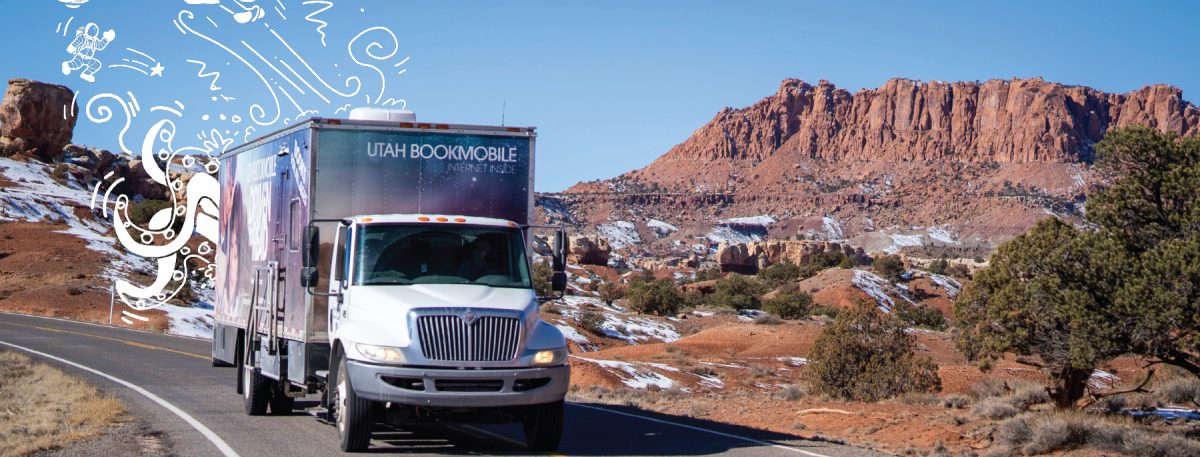Stocking shelves, truck whispering and technical support are all part of a bookmobile driver’s job in the digitalage.
By Ellen Fagg Weist | Photography by Faun Jackson
Urban readers — that is, Utahns who live near city and county library branches — might consider bookmobiles a relic of their childhoods. Or maybe the setting for a “gentle reads” novel, the kind of mystery caper that avoids sex or adult language.
In fact, if the state hadn’t been operating bookmobiles since 1958, it’s likely a perceptive Utah writer might have invented the concept.

A truck stocked with books seems anachronistic and yet essential in a wide-open state like Utah. “Magical” is a word students often use to describe their bookmobile.
“We’re just small enough where I can take care of people,” says Becky Lopshire, who has been driving the Tri-County Bookmobile for 13 years through Sevier, Piute and Wayne counties. “People are so happy to see you, they are so grateful for what you bring.”
‘As relevant as ever’
On a recent Wednesday morning, driver Shawn Bliss parks a 40-foot diesel truck in the parking lot of a Church of Jesus Christ of Latter-day Saints meetinghouse in Spanish Fork. The slogan “Driven to read” is emblazoned on the outside, making this sprawling truck hard to miss.
The open shelves in the carpeted truck make it easy to browse from children’s books to fiction to parenting guides to contemporary novels by Utah authors like Ally Condie and Shannon Hale and the fantastical Brandons — Brandon Sanderson and Brandon Mull.
Bookmobiles “are lifesavers to all of us country folk. I love them,” says Nadene Roberts, who has been coming to the Utah County bookmobile for more than 20 years.
Bliss and Lopshire are two of the seven drivers for the Utah State Library’s Bookmobile fleet, which partners with 10 counties to deliver mobile library services. “Bookmobiles are as relevant today as ever,” says national consultant Michael Swendrowski.
“Gangbusters” is how he describes the demand, following a downturn in public funding after the Great Recession. Manufacturers are selling bookmobiles faster than they can build them, with a backlog of orders that stretches three to five years, Swendrowski says.
Avoiding ‘option paralysis’
Bookmobile services vary throughout the country, from reading outreach programs targeted at preschools or senior centers to traveling Wi-Fi hotspots to the traditional book-lined buses. Most bookmobiles are operated by city or county library systems. Utah’s state-county funding partnership is unusual, says Swendrowski, a consultant for the Association of Bookmobile and Outreach Services, an arm of the American Library Association.
In rural Utah counties such as Wayne and Piute, bookmobiles offer the only library services. In contrast, Alpine and Vineyard, two of Utah County’s fast-growing young cities, have opted to contract for bookmobile services until they have money to build physical library buildings.
For most of their workdays, the drivers think about books, about what their regulars might enjoy reading, about what books they should add to the collection. But the rest of the time, they are truck whisperers, diagnosing the sounds of the diesel engine, fussing over what the mechanical or heating or air conditioning systems might need.
When a truck is out of service, updates are posted on the bookmobile’s schedule page, but regulars are just as likely to call their neighbors and spread the word.
Each Utah bookmobile stocks more than 5,000 books and DVDs, and those carefully curated collections can help with what Bliss calls “option paralysis.”
“We try to have a little something at every level” on the truck, Bliss says, supported by an additional collection at each bookmobile’s headquarters library. In addition, just about any book can be purchased or ordered through the state’s interlibrary loan program.
At the Benjamin stop, patrons discussed local dustups over wells and water rights. One reader, as he was checking out three Western mysteries by Craig Johnson, labeled himself a “move-in,” as he had only lived in the area for 30 years.
Full-circle cycle of bookmobile readers
That conversation underscores the way bookmobiles can serve as a community gathering space, Bliss says, which seems especially important in small towns without public diners or coffee shops.
“You get a feel for what people want,” says Lyle Talbot, who drives Garfield and Kane’s Multi-County Bookmobile. After 35 years of driving a truck while living along the Wasatch Front, Talbot retired to his native Panguitch eight years ago. He quickly found out he wasn’t good at retirement.
Now he’s back on the road, driving a bookmobile route that stops at seven schools. Every two weeks, he drives the hairpin curves of the Hell’s Backbone road connecting Escalante to Boulder, considered one of the most scenic drives in the country. He marvels that he gets paid to see such spectacular views.

At first, bookmobile drivers might have to tease out a new patron’s reading interests. Over time, they’re likely to learn the reading tastes of regulars. “And then when a new book comes in, you save it for them,” Lopshire says. “You get to know them so well you’re considered a friend.”
For longtime bookmobile drivers, it can be a full-circle job. They watch young readers grow up, settle down, then bring their kids, and later grandkids, to the bookmobile. Sometimes drivers don’t learn one of their regulars has passed away until their kids return their overdue books.
Dixon Eliason, of Delta, drove a bookmobile for more than 35 years before he retired from the Millard/Juab County route in 2014.
Notably, government budgets fund life-saving services, like fire and police departments, he says, but “I can’t help but think that libraries and bookmobiles have saved people’s lives also.”

